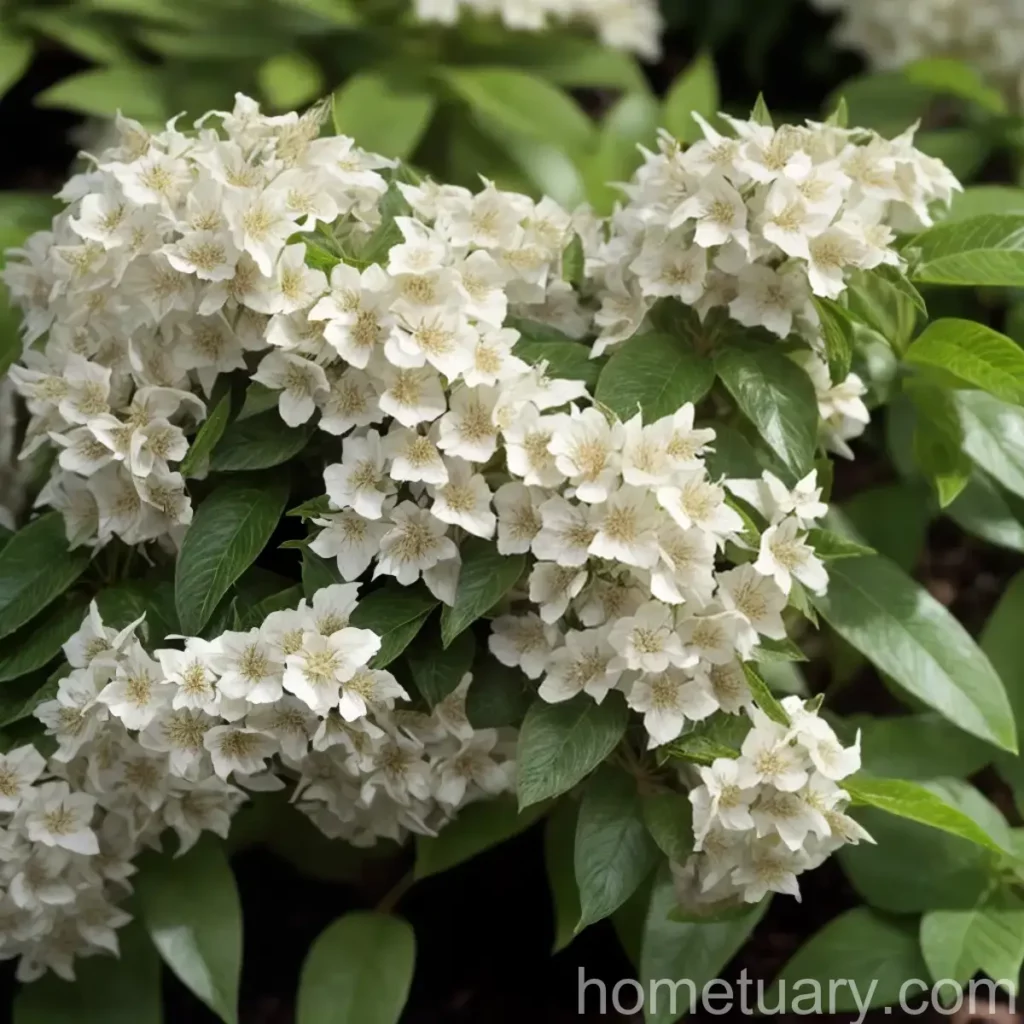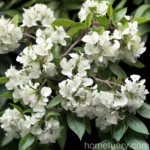Abelia ‘Edward Goucher’: A Complete Guide
Introduction
Abelia ‘Edward Goucher’ is a popular landscaping plant known for its ornamental features, adaptability, and low maintenance. This evergreen shrub belongs to the Caprifoliaceae family and is native to Italy.
In this comprehensive guide, we will explore the key characteristics of Abelia ‘Edward Goucher’, its care requirements, landscape uses, varieties, and much more. Whether you are a seasoned gardener or a beginner, this guide will provide you with valuable insights into cultivating and caring for this beautiful shrub.
Abelia ‘Edward Goucher’ Characteristics
Abelia ‘Edward Goucher’ is prized for its attractive foliage and prolific blooms. The key characteristics of this plant include:
-
Foliage: The foliage of Abelia ‘Edward Goucher’ is glossy and ovate, with a lustrous deep green color. The leaves often take on attractive bronze tints in the fall, adding to the plant’s visual appeal.
-
Flowers: One of the most striking features of Abelia ‘Edward Goucher’ is its abundant clusters of funnel-shaped, lavender-pink flowers. These blooms appear from summer to fall and are highly attractive to pollinators.
-
Size: This shrub typically reaches a height and spread of 3-4 feet, forming a compact and mounding shape.
-
Hardiness Zone: Abelia ‘Edward Goucher’ is well-suited to grow in USDA hardiness zones 5-9, making it adaptable to a wide range of climates.
Abelia ‘Edward Goucher’ Care
Water
When it comes to watering Abelia ‘Edward Goucher’, it is important to maintain consistent moisture, especially during the plant’s establishment phase. Once established, this shrub exhibits good drought tolerance, but it is advisable to provide supplemental water during prolonged dry spells.
-
Establishment: Water newly planted Abelia ‘Edward Goucher’ regularly, ensuring that the soil is consistently moist but not waterlogged.
-
Mature Plants: Mature plants generally require less frequent watering, but it is essential to provide supplemental irrigation during periods of extended drought.
Sunlight
Abelia ‘Edward Goucher’ thrives in full sun to partial shade. To ensure optimal growth and flowering, it is recommended to plant this shrub in a location that receives at least 6 hours of sunlight per day.
-
Full Sun: When planted in full sun, Abelia ‘Edward Goucher’ tends to exhibit the best flowering and overall vigor.
-
Partial Shade: In regions with intense summer heat, providing partial shade during the hottest part of the day can help protect the plant from stress.
Soil
The soil preferences of Abelia ‘Edward Goucher’ lean towards well-draining, fertile soil with a slightly acidic to neutral pH. Amending the soil with organic matter can further enhance its growing conditions.
-
Texture: A loamy soil texture is ideal for Abelia ‘Edward Goucher’, as it provides a balanced mix of drainage and moisture retention.
-
pH: The soil pH should ideally range from 5.5 to 6.5, creating an optimal environment for nutrient uptake.
Fertilizer
Proper fertilization can support the growth and blooming of Abelia ‘Edward Goucher’. During the growing season, a balanced, slow-release fertilizer can be applied to provide essential nutrients.
-
Timing: Apply fertilizer in early spring as new growth begins, and consider a second application in mid-summer if the plant shows signs of nutrient deficiency.
-
Composition: Look for a fertilizer with a balanced NPK ratio, such as 10-10-10, to promote overall plant health and flowering.
Pruning
Pruning plays a crucial role in maintaining the shape, size, and flowering performance of Abelia ‘Edward Goucher’. With proper pruning techniques, you can rejuvenate the plant and encourage abundant blooms.
-
Timing: Prune Abelia ‘Edward Goucher’ in late winter to early spring before new growth emerges. This timing allows the plant to allocate energy to the emerging buds and promotes vigorous flowering.
-
Techniques: Use sharp, clean pruners to remove dead or damaged branches, shape the shrub, and promote air circulation within the canopy.
Abelia ‘Edward Goucher’ Landscape Uses
Abelia ‘Edward Goucher’ offers versatile landscaping possibilities, thanks to its ornamental appeal, adaptability, and low maintenance requirements.
Border Plant
The compact size and attractive foliage and flowers of Abelia ‘Edward Goucher’ make it an excellent choice for border plantings. Whether used as a single specimen or in mass plantings, this shrub adds visual interest and a pop of color to garden borders.
Hedge
When planted in a row, Abelia ‘Edward Goucher’ can be shaped into a beautiful flowering hedge. Regular pruning helps maintain a dense and uniform hedge that provides privacy and attracts pollinators.
Mixed Borders
In mixed borders and perennial gardens, Abelia ‘Edward Goucher’ serves as a valuable addition, offering its blooming display and year-round appeal alongside other herbaceous and woody plants.
Container Gardening
The compact growth habit of Abelia ‘Edward Goucher’ makes it suitable for container gardening. Whether grown in patio pots or decorative containers, this shrub can add a touch of elegance to outdoor spaces.
Abelia ‘Edward Goucher’ Varieties
Several cultivars and related species of Abelia are available, each with its unique features and adaptations. While Abelia ‘Edward Goucher’ is a particularly popular variety, it is worth exploring other options to diversify your garden and landscape.
-
Abelia x grandiflora: This hybrid abelia offers a profusion of white, fragrant flowers and a dense, mounding growth habit.
-
Abelia mosanensis: Also known as Korean abelia, this species showcases fragrant white blooms and vibrant fall foliage.
-
Abelia chinensis: With graceful arching branches and pale pink flowers, this species adds a delicate touch to garden landscapes.
Abelia ‘Edward Goucher’ Common Diseases
Abelia ‘Edward Goucher’ is generally resistant to most common plant diseases, especially when grown in favorable conditions and provided with proper care. However, it is essential to remain vigilant for potential issues that can impact the health of the plant.
-
Powdery Mildew: In humid or poorly ventilated conditions, Abelia ‘Edward Goucher’ may be susceptible to powdery mildew, a fungal disease that manifests as powdery white spots on the leaves.
-
Leaf Spot: Fungal leaf spots can occur under conditions of high humidity and wet foliage. These spots may initially appear as small lesions and can expand, affecting the overall health and appearance of the plant.
Disease Diagnosis
If you observe any signs of disease on your Abelia ‘Edward Goucher’ plants, it is important to accurately diagnose the issue to implement effective management strategies.
-
Symptoms: Carefully observe the patterns and characteristics of the symptoms, such as leaf discoloration, wilting, or the presence of fungal growth.
-
Environmental Conditions: Consider the prevailing environmental conditions, including temperature, humidity levels, and air circulation, as these factors can contribute to disease development.
-
Professional Consultation: If you are uncertain about the diagnosis or need assistance in developing a treatment plan, seek guidance from a local horticulturist or plant health expert.
Abelia ‘Edward Goucher’ Common Pests
While Abelia ‘Edward Goucher’ is generally resistant to most pests, it may occasionally encounter the following insect nuisances:
-
Aphids: These small, soft-bodied insects can cluster on the tender shoots and foliage of the plant, sucking sap and potentially causing distortion and discoloration of the leaves.
-
Spider Mites: In hot and dry conditions, spider mites may infest Abelia ‘Edward Goucher’, causing stippling and webbing on the undersides of the leaves.
Pest Management
To manage pest infestations on Abelia ‘Edward Goucher’, consider employing the following tactics:
-
Natural Predators: Encourage the presence of beneficial predators, such as ladybugs and lacewings, which feed on aphids and mites.
-
Horticultural Oils: Application of horticultural oils can smother and suffocate pests while being gentle on the plant.
-
Pruning: Remove heavily infested portions of the plant and dispose of them properly to prevent the spread of pests.
Botanist’s Tips for Success
As a plant scientist, I highly recommend the following tips to ensure the success and vitality of Abelia ‘Edward Goucher’ in your garden:
-
Site Selection: Choose a planting site with well-draining soil and ample sunlight to provide an ideal growing environment for Abelia ‘Edward Goucher’.
-
Mulching: Apply a layer of organic mulch around the base of the plant to conserve soil moisture, suppress weed growth, and regulate soil temperature.
-
Regular Monitoring: Routinely inspect your Abelia ‘Edward Goucher’ plants for signs of disease, pest activity, or nutrient deficiencies, intervening promptly if issues arise.
-
Proper Pruning: Employ proper pruning techniques to maintain the desired shape and size of the shrub, while also promoting flowering and overall health.
-
Watering Consistency: Practice consistent watering, particularly during the establishment phase and dry spells, to support the plant’s vigor and resilience.
Fun Facts about Abelia ‘Edward Goucher’
-
Abelia ‘Edward Goucher’ is named after Edward Goucher, a renowned nurseryman from Howard County, Maryland, known for his contributions to horticulture.
-
The flowers of Abelia ‘Edward Goucher’ are not only visually appealing but also emit a delightful, sweet fragrance, enhancing their allure to humans and pollinators.
-
This shrub is highly attractive to butterflies, bees, and hummingbirds, making it a valuable addition to wildlife-friendly gardens.
Links to External Resources
To further your knowledge and understanding of Abelia ‘Edward Goucher’, I recommend exploring the following external resources:
- American Horticultural Society
- Royal Horticultural Society
- University Cooperative Extension Services
- North American Native Plant Societies
In summary, Abelia ‘Edward Goucher’ stands out as a versatile and visually captivating shrub that can enrich gardens, landscapes, and outdoor spaces with its year-round appeal. By providing appropriate care, attention, and suitable growing conditions, you can experience the full potential of this remarkable plant in your own gardening endeavors.
Keywords: Abelia ‘Edward Goucher’ characteristics, Abelia ‘Edward Goucher’ care, Abelia ‘Edward Goucher’ pruning, Abelia ‘Edward Goucher’ growth, Abelia ‘Edward Goucher’ planting tips, Abelia ‘Edward Goucher’ landscape uses, Abelia ‘Edward Goucher’ varieties, Abelia ‘Edward Goucher’ flowers, Abelia ‘Edward Goucher’ foliage, Abelia ‘Edward Goucher’ maintenance, Abelia ‘Edward Goucher’ drought tolerance, Abelia ‘Edward Goucher’ disease resistance, Abelia ‘Edward Goucher’ pests, Abelia ‘Edward Goucher’ winter care, Abelia ‘Edward Goucher’ sun requirements, Abelia ‘Edward Goucher’ shade tolerance, Abelia ‘Edward Goucher’ soil preferences, Abelia ‘Edward Goucher’ watering needs, Abelia ‘Edward Goucher’ companion plants, Abelia ‘Edward Goucher’ landscaping ideas, Abelia ‘Edward Goucher’ container gardening, Abelia ‘Edward Goucher’ bloom time, Abelia ‘Edward Goucher’ pollinators, Abelia ‘Edward Goucher’ wildlife attraction, Abelia ‘Edward Goucher’ fall color, Abelia ‘Edward Goucher’ flower power, Abelia ‘Edward Goucher’ growth habits, Abelia ‘Edward Goucher’ hardiness zone, Abelia ‘Edward Goucher’ fragrance, Abelia ‘Edward Goucher’ border plant, Abelia ‘Edward Goucher’ hedge, Abelia ‘Edward Goucher’ landscape design, Abelia ‘Edward Goucher’ seasonality, Abelia ‘Edward Goucher’ growing tips, Abelia ‘Edward Goucher’ pruning techniques, Abelia ‘Edward Goucher’ propagation methods, Abelia ‘Edward Goucher’ foliage color, Abelia ‘Edward Goucher’ erosion control, Abelia ‘Edward Goucher’ cutting flowers, Abelia ‘Edward Goucher’ flower arrangement, Abelia ‘Edward Goucher’ groundcover, Abelia ‘Edward Goucher’ native habitat, Abelia ‘Edward Goucher’ medicinal uses, Abelia ‘Edward Goucher’ edible parts, Abelia ‘Edward Goucher’ folklore, Abelia ‘Edward Goucher’ folklore, Abelia ‘Edward Goucher’ common names, Abelia ‘Edward Goucher’ plant family, Abelia ‘Edward Goucher’ tolerance to heat, Abelia ‘Edward Goucher’ tolerance to humidity















